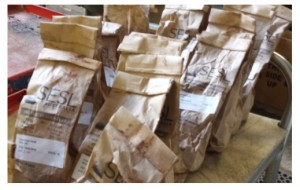 Have you ever had a plant or tree die on you without any apparent reason? Does it make you wonder what the heck you did wrong or what mysterious disease the plant picked up … or does it perhaps leave you suspecting the neighbour of some foul play? Many times I’ve seen plants suddenly drop dead while others around them seem to thrive, so what’s the deal? Without getting too X-files about it, how can we solve the mystery of deciphering whether it’s a pest, pathogen or poison?
Have you ever had a plant or tree die on you without any apparent reason? Does it make you wonder what the heck you did wrong or what mysterious disease the plant picked up … or does it perhaps leave you suspecting the neighbour of some foul play? Many times I’ve seen plants suddenly drop dead while others around them seem to thrive, so what’s the deal? Without getting too X-files about it, how can we solve the mystery of deciphering whether it’s a pest, pathogen or poison?
The answer comes through SESL Australia – Sydney Environmental and Soil Laboratory – a plant and soil testing facility like no other in Australia. It is unique because it’s all about horticulture in the urban terrain and getting to the bottom of “what’s wrong with my plant?”. Established in 1984 by soil scientist, Simon Leake, it offers specialist consultancy and testing to give you the answers and practical solutions based on horticultural science rather than a general pathology service for broad acre farming.
I had the pleasure of meeting Simon during an organised tour of the lab, to see exactly what goes on and how these conclusions are made. Simon certainly knows his stuff. He’s been responsible for creating soil for some of Sydney’s top landscaping icons such as the proposed redevelopment of the Sydney foreshore at Barangaroo as well as Patrick Blanc’s wall garden on the building at 1 Bligh Street, Camperdown.
Both sites are challenged with being a man-made feature that’s supposed to resemble nature under the most extreme environments. It’s Simon’s understanding of plants and and their relationship with the soil, that sets him apart from the others and made him the number one choice to develop soils for these iconic projects.
But what about that tree that suddenly dropped dead near your neighbour’s house?
Like any good doctor, “Dr Dirt” as I like to call him, asks a host of questions before he gets into the lab. He’s the specialist that makes the invisible become visible! Often a story around a plant can provide many answers or at least a direction for further testing.
What is your relationship like with your neighbour?
Do you have a view?
What was the site used for before you built there?
What species is the plant?
What is the moisture like around the roots?
Have you used any pesticides?
And so on …
Not every enquiry involves lab testing. Some deductions can be made simply by answering these questions and knowing the type of plant. A single plant in a hedgerow that suddenly doesn’t conform may be the result of a water course underneath it. A low point or poor drainage in one area can rot the roots of a plant without necessarily spreading to others around it. It might not be evident until you have a long period of heavy rain or structural changes to neighbouring sites that directs the watercourse and encourages puddling in one spot.
Certain species of plants are particularly vulnerable to specific mineral deficiencies that are shown up very clearly by leaf margins appearing red, yellowing or a generally pale in colour. Other plants may be vulnerable to deficiencies and show up as specific problems like blossom end rot in tomatoes and zucchini. A simple addition of agriculture lime (calcium carbonate) can be the solution.
It can certainly save you some money without further tests. A basic soil test will cost you about $70 but more extensive pathology work, like testing for glyphosate poisoning, will cost you around $300.
Soil samples are each dried out at 40C and then ground into a powder. The sample is put into a water solution where particulates are removed and the extract is then tested for mineral elements. SESL has equipment that can give results for almost all elements needed for plant growth in a single test (keeps things cheaper for you).
A whole range of tests are carried out at SESL and being an independent laboratory, you can be sure to get unbiased results. A report explaining the results of soil and/or plant tissue tests is given along with recommendations to remedy the situation. It’s certainly going to give you the answers you need and if you can’t understand the report, the staff at SESL are only a phone call away to help explain it all for you.
SESL are also heavily involved in preparing and maintaining standards for compost generated by the green waste from your kerbside collection.
You can keep in touch with what’s happening in soil science by subscribing to SESL blog “Fertile Minds”.











 Twitter
Twitter Facebook
Facebook